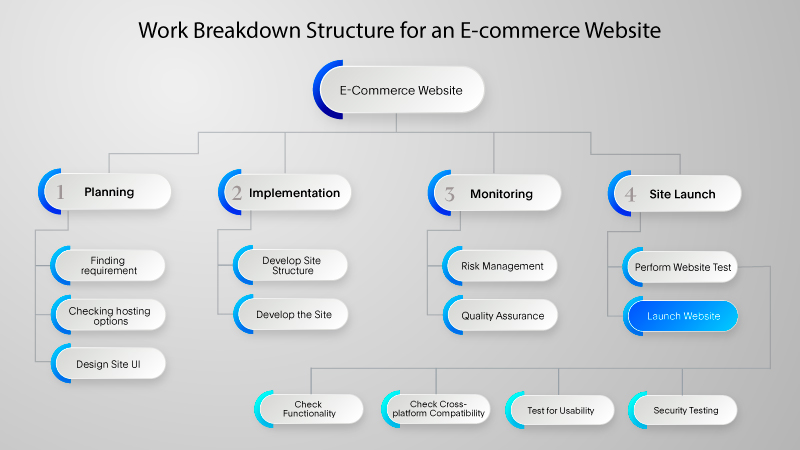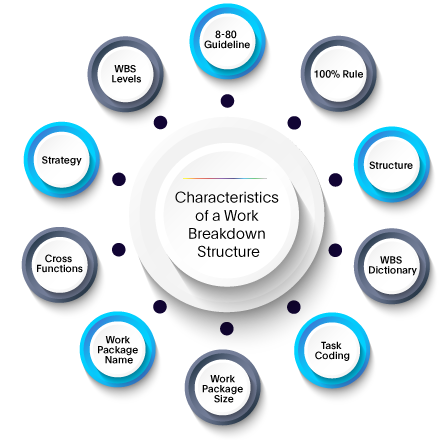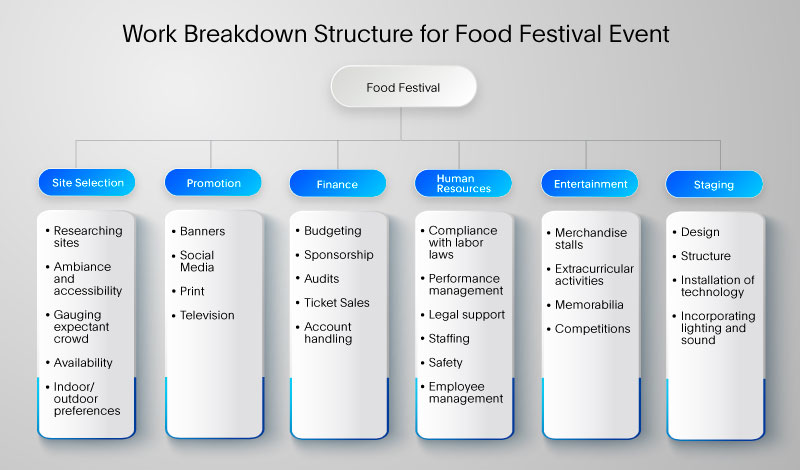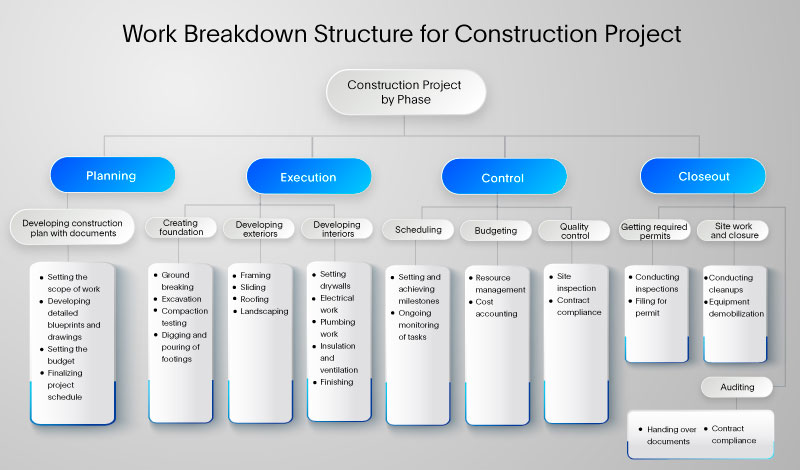
Many projects fail because project managers don’t have a clear picture of the tasks and deliverables to be achieved.
Having a vision of what lies ahead in a project can greatly help project managers build a concrete work plan. This benefits all the parties involved and also ensures that projects are completed successfully on time. That’s where a Work Breakdown Structure (WBS) helps.
As one of the most basic but significant components of project planning, it’s primarily designed to help project managers supervise projects effortlessly and team members complete their tasks on time. All of this ensures a faster and more efficient project turnaround.
Let’s learn more about what a Work Breakdown Structure is, its benefits, its characteristics, and its types as we move ahead.
What Is a Work Breakdown Structure?
In simple words, a Work Breakdown Structure can be defined as a project management tool that breaks down the main project deliverables into smaller and more manageable tasks, also known as work packages. Each of these work packages is more detailed and includes internal, interim, and external deliverables.
For instance, if you’re tasked with building an e-commerce website (the main deliverable), you can’t just start without a vision. Websites are the face of an organization. So, every element has to be worked on carefully.
The diagram below visually represents a Work Breakdown Structure for an e-commerce website.
As you can see here, the main deliverable is first divided into four broad work groups, namely –
- Planning
- Implementation
- Monitoring
- Launch
The four work groups are further divided into sub-tasks, which can be seen in the diagram as follows:

Each of the sub-tasks here can be broken into even smaller work packages as required by the project.
Before we dive further, let’s look at how Work Breakdown Structure came into the picture for project management.
Work Breakdown Structure: A Brief History
Here are some of the important milestones in the development and popularization of a Work Breakdown Structure:
1962: The concept was described by NASA and the Department of Defense (DOD).
1968: The Defense Department published the document “Work Breakdown Structures for Defense Materiel Items” a military criterion that required such structures to be used across the department. The document is still active and was last revised in May 2023.
1987: Using a Work Breakdown Structure was established as a standard practice for other non-military applications by the Project Management Institute (PMI).
1993: The term was introduced into the corporate world for applications in projects.
1999: The PMI Standards Program issued a project charter to devise the Work Breakdown Structure Practice Standard.
Characteristics of a Work Breakdown Structure
Without a good Work Breakdown Structure, it’s almost unimaginable to have accurate estimates of the tasks and deliverables in a project. In fact, as the project progresses, you might even encounter serious issues if the structures are not properly developed.
Therefore, to be truly effective, such a structure should possess the following characteristics or elements as illustrated below.

Let’s dive deeper into these characteristics to get a clearer picture.
8-80 Guideline
According to this guideline, the efforts for all work packages in the structure must have a duration of 8 to 80 hours. In other words, the work packages should be completed within 8 hours of 1 day to 80 hours in 10 days. If a project is small, work packages can follow the 8-hour rule, whereas larger projects can go for the 80-hour guideline.
100% Rule
In project management, this rule requires the structure to include 100% of the work as mentioned in the project scope. Moreover, this characteristic requires it to take all the internal and external deliverables of the project into consideration.
Structure
A good Work Breakdown Structure is detail-oriented and explains all the elements required to create and deliver the project. This way, everyone involved will have a clear understanding of what they’ll be doing and how the tasks must be delivered.
WBS Dictionary
This is another important characteristic of a good structure. This is where you can find all the details of the project, such as deliverables, tasks, milestones, resources, costs, and project scope. With a WBS dictionary, the entire information of a project is visually expressed so that everyone involved can easily grasp the concepts and stay organized.
Task Coding
This characteristic ensures that all work packages are coded uniquely for identification. Coding the work packages helps keep the project under control while also ensuring that each task can be easily monitored.
Work Package Size
Work packages must be unique and must not be replicated elsewhere on the structure. That’s why a good structure ensures reasonable work package sizes that can be delivered within a defined timeframe. Ideally, the size of a work package should be shorter than a project’s reporting period.
Work Package Name
Every work package name is a noun that describes the end product. This feature is fundamental for a good structure since work packages describe deliverables, not the activities. If the work packages in your structure use verbs, then you’re on the wrong path.
Cross Functions
A useful feature of the structure is that it empowers you with the ability to design tasks and monitor processes for cross-functional corporate projects.
Strategy
Another great characteristic is that it helps project managers develop strategies at different phases of a project, which, in turn, aids in executing tasks more effectively.
WBS Levels
This characteristic of the structure identifies the hierarchy of a WBS element. Primarily, a work breakdown structure has three levels:
Level 1 contains the final goal of a project
Level 2 contains the outcome of a project
Level 3 contains the output of the project
However, depending on the size and intricacy of a project, more levels may be added to the structure.
Illustration of a Work Breakdown Structure
It’s mostly represented as a tree diagram. However, numbered lists or tables can also be used. These illustrations include the following elements to maximize its strength.
1. Internal, interim, or external deliverables required to complete the project
2. Hierarchical connections between the project deliverables
3. Resource management to estimate the costs and duration required for completing a project
4. Specifically assigned responsibilities, making them manageable and easy to finish
5. Start and end dates along with measurable milestones to gauge project progress accurately
6. Flexibility to accommodate minor changes like adding new tasks or changes in deadlines.
7. A complete overview of the expected deliverables to avoid scope creep
Most importantly, the structure must be created by the project manager who is in charge of the project.
Different Types of Work Breakdown Structure
You can use different kinds of structures to figure out what needs to be done in a project and how it should be done. Here are 7 structures to get you started.
Process-Oriented WBS
This structure divides tasks into processes to ensure the completion of a project. It can include elements like testing, requirements, development, and design. This type of structure is beneficial for project managers because it provides clarity about the tasks while assigning task owners.
Furthermore, the process-oriented structure helps in assigning resources and estimating time easily at each level of the structure. This is one of the most preferred structures by clients because of its ability to provide clear milestones throughout the project.
Phase-Based Work Breakdown Structure
As the name suggests, this structure breaks projects into phases, which are further divided into smaller tasks and simpler subtasks. Every phase in the structure possesses its own features and objectives.
Deliverable-Oriented Work Breakdown Structure
This type of structure is represented by a hierarchical tree structure that depicts the overall project and its constituents.
The structure works by breaking tasks into substantial products or services. The structure aids by showing the connection between any high-level deliverables within the project and the work that needs to be done.
This type of structure provides an overall view of the entire project from the beginning to the end via a horizontal representation of the work with activities relating to one another. Project management teams prefer this type of structure due to the clarity it provides regarding the deliverables required for a project.
Resource Breakdown Structure
This structure type deals with resource management that’s necessary to complete each work package. The structure can be obtained by first identifying the work packages that need resources to be completed. After that, the resources can be collected and organized into hierarchies based on their likeness or uniqueness.
Resource Breakdown Structure ensures that a project has all essential resources required for completion and that there are no conflicts while using them, which could delay the project.
Risk Breakdown Structure
This structure divides risks related to a project into categories and subcategories so that they can be managed efficiently.
In this structure, the risk categories can be depicted by their sources, types, or other ways deemed appropriate for a particular project. Schedule, scope, cost, or quality are some of the risk categories that might come up in a project.
Cost Breakdown Structure
This type of structure displays the estimated cost of each element in a project. With a Cost Breakdown Structure, project managers can easily estimate a project’s budget and keep costs under control.
Organizational Breakdown Structure
We can get a clear picture of the roles assigned for a project within an organization with the help of this. It identifies team members according to their order of importance, starting from the top of the hierarchy to the bottom, while clearly stating the tasks that these employees are responsible for.
Examples of Work Breakdown Structure
Below are two examples of structures used for different projects.
Work Breakdown Structure for Event Management
It’s important to know how much work needs to be done to make an event happen. Event managers can’t plan the event, let alone manage all the countless changes that might take place during events, without understanding the scope.
A Work Breakdown Structure for Event Planning can do wonders in such cases. Here’s what it can look like:

Work Breakdown Structure for Construction
This is a detailed structure that shows each phase of a construction project right from the planning stage. It’s pretty clear in this example of Work Breakdown Structure that all the different parts of the project are divided into different levels.
Level 1 shows the main deliverable which is the construction project. On Level 2, we see a breakdown of the different phases of the construction work which are-
1. Planning
2. Execution
3. Control
4. Closeout
Going forward, on Level 2, each of these phases is further divided into sub-tasks. If required these sub-tasks are further broken into smaller work packages that can easily be assigned to teams involved.

Run Successful Projects With Work Breakdown Structures
Project management can be challenging which is why it requires careful planning and organization to reach the final goal successfully. In conclusion, it can be said that Work Breakdown Structure lays the foundation for managing projects efficiently. As difficult as it seems, creating it is easy, especially when one starts to get the hang of it.
Adding a visual hierarchy, via this structure, can prove beneficial to project managers, teams, and clients alike. The clear representation of tasks right from the beginning to the end keeps everyone on the same page, thus leaving no room for error.
It’s, however, important to bear in mind that the design of your structure will vary based on the scope of your project, its intricacy, its time frame, and the software you select to use. So, if yours looks different from the rest, don’t fret over it. Just ensure that all elements are in place and your project will run smoothly and efficiently throughout its timeline.